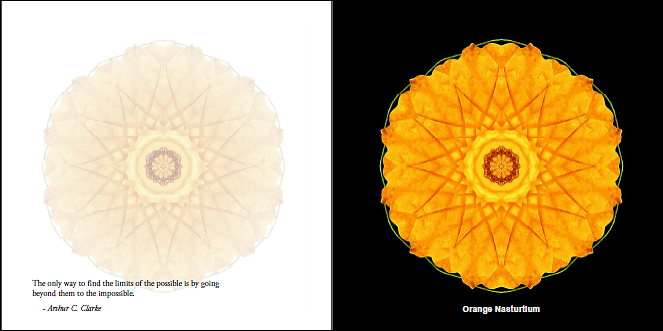NOTE: This is the first draft of the “Possibility” essay in my forthcoming book, Fifty-Two Flower Mandalas.
Responses and comments welcome, no matter how brief.

Possibility: More powerful than a locomotive
Copyright 2013 David J. Bookbinder
Much of my childhood took place in the realm of possibility: machine intelligences, aliens, mutants, future worlds, alternate pasts. Infinite possibilities.
My first science fiction book was Isaac Asimov’s I, Robot. I was 10 when I found a marked-up copy at a Temple Sinai rummage sale my mother had helped to organize. It opened the universe to me.
Soon, weekly, I wandered over to the adult section of the library across from my elementary school and took out as many science fiction books as the librarian would allow. I’d haunt the local pharmacy’s rack of science fiction and mystery novels, trying to figure out how best to allocate my 50-cent allowance. By my early teens, I had amassed a collection of several hundred science fiction books, many of them ACE paperbacks that contained two short novels, back to back, each with its own lurid cover; I had read twice as many more.
At around the time I discovered Asimov, I decided I wanted to be a “space scientist,” a dream that carried me all the way through my first year at Cornell University’s engineering school. By college, I had stopped reading science fiction – I’d put away childish things – but my love affair with it never really ended. Twenty years later, I was in a PhD program in English, and I couldn’t absorb or readily follow the dry, abstract, literary theory that English Studies had devolved into. To take a break from it, I revisited the science fiction stories I had read as a boy – and discovered layers of meaning that it is hard to believe I fully grasped when I’d first encountered them. I’m still reading, and sometimes rereading, these authors, as well as the many thought-provoking science fiction writers who have come along since then.
I was not the only young boy whose interest in science started with science fiction. Re-reading the stories and novels I read then, I’m often astonished by the practical boon science fiction has provided. The list of inventions and discoveries that became possible because science fiction writers imagined them, and children who read their stories grew up to become engineers who built them, is long. It includes: space flight, scanning for habitable planets and alien life, biodomes, computers, robots, artificial intelligence, virtual reality, flat-screen televisions, as well as the many subsidiary products derived from these inventions. A scene in the 1997 film Trekkies illustrates the widespread technological influence of just one short-lived television series. At a meeting of NASA scientists, the audience members whose careers were inspired by Star Trek are asked to come up on the stage. Dozens responded, emptying the auditorium seats like graduating high school seniors called to receive their diplomas. Star Trek alone inspired cell phones, video conferencing, speech recognition, tablet computers, medical imaging, hyposprays, memory cards, biometrics, wireless earpieces, 3-D printers, machine translators, and directed-energy weapons, among others.
But at least as important as its technological influences is science fiction’s re-imagining of the possibilities of human potential.
In the introduction to her gender-bending novel The Left Hand of Darkness, Ursula Le Guin, one of the genre’s most accomplished authors, describes the power of science fiction to act as a lens on human possibility. “If you like you can read it, and a lot of other science fiction, as a thought-experiment. Let’s say (says Mary Shelley) that a young doctor creates a human being in his laboratory; let’s say (says Philip K. Dick) that the Allies lost the second world war; let’s say this or that is such and so, and see what happens. In a story so conceived… thought and intuition can move freely within bounds set only by the terms of the experiment, which may be very large indeed.”
Rod Serling’s 1960s series The Twilight Zone is one example among the many whose thought experiments explored, in science fiction, sociopolitical realities and possibilities that would have been suppressed in conventional media. Serling wrote for several of the best television dramatic series of the 1950s, but he was often confounded by censors. To bypass them, he migrated topics such as bigotry, gender roles, government oppression, politics, war, and explorations of the darker sides of human nature to distant planets, future times, or reimagined versions of the present – places where the censors were not paying close attention.
Although it has a reputation as “escape” fiction (and some of it is), the science fiction genre contains some of the most thought-provoking and skillfully executed works in all of literature. On a scale more ambitious than most conventional fiction, science fiction imagines answers to the largest questions: How did this universe come into being? How will it end? Where does consciousness come from? What is its purpose? How will we end? Who will replace us?
In some cases, the borrowings are deliberate. Films such as The Matrix explicitly explore Buddhist concepts such as m?y? (illusion), and the Star Wars series was based on Joseph Campbell’s pioneering work in world mythology. But the thought experiments of science fiction have also independently stretched the limits of human imagination in ways that sometimes exceed the reach even of the mystical teachings of the world’s religions. (I think of my own spirituality as 50% Buddhism, 50% science fiction.)
Science fiction films and stories continue to push beyond the limits of present knowledge, inspiring us to reach not only for the stars, but deeply into ourselves. In this way, science fiction overlaps with the real aim of psychotherapy, another means through which to boldly go where we have not gone before.
In today’s insurance-managed world, psychotherapy has become just another medical modality. It is referred to as “behavioral health,” and client sessions are predicated on “medical necessity.” There are a plethora of standardized diagnoses that are constantly being refined and redefined, and from them flow endless treatment protocols.
However, as science fiction is not only about space operas, robots, time travel, and aliens, but also has social, philosophical, psychological, and spiritual dimensions, so psychotherapy is not only about diagnosis and “medical necessity,” insurance companies notwithstanding. Psychotherapy, too, is about making the “impossible” not only possible, but probable, through an act of imagination.
Psychotherapy, like science fiction, catalyzes transformation by seeing possibilities and mirroring them back, eventually overwhelming perceived limitations.
I do what I do today largely because my own therapist saw my possibilities and reflected them back to me. In a paying-it-forward manner, much my clinical work takes place in the realm of possibility. I strive to inspire those who come to me to actualize the selves they were born to but which, for a variety of reasons, have so far been denied them.
Like the science fiction writers I admire, I create a laboratory where thought experiments can be carried out. My clients ask: What if I were to test this limit, take steps down that path, hold my breath and plunge into these waters? They imagine their preferred lives and then carry them out. If they are not yet ready, I hold their possibilities in my mind and heart, reflecting them back however I can. Over time, if they stay with it, what they deemed impossible, what their parents or teachers or peers believed they could never do, nearly always happens.
Often I am only one of a succession of supporters who see the possibilities in my clients and fan the small sparks into flames. Thus, the woman who was told she was “stupid” becomes a brilliant attorney. The boy who was sidelined into special ed because there was nowhere else to put him prepares to enter M.I.T. The isolated and friendless become deeply embedded in their communities. The “hopelessly” addicted banish their demons and guide others along the path to recovery. The lonely find love, the frightened courage, the suicidally depressed discover their purpose.
The late Christopher Reeve, who played the omnipotent Superman, once said, “So many of our dreams at first seem impossible, then they seem improbable, and then, when we summon the will, they soon become inevitable.” He died before his personal struggle to regain mobility, after an accident paralyzed him, bore fruit, but he never gave up pursuing the possibility. He became the wounded healer whose injury helped him focus his attention, compassion, and resources on people similarly afflicted, seeing in them the possible, even the inevitable, where others had seen only their handicaps.
It is difficult to believe in yourself when you do not, first, have someone who believes in you. But you don’t have to be Superman, a therapist, or even a science fiction fan to believe in possibilities. It is as easy to do as it is to resist doing. All it requires is an act of imagination and the willingness to sustain it.
Discussion: Facebook Flower Mandalas page
Subscribe to the Flower Mandalas mailing list
Request the 15 Flower Mandalas screensaver: Fifteen Flower Mandalas
Text and images © 2013, David J. Bookbinder. All rights reserved.
Permission required for publication. Images available for licensing.
flowermandalas.org

